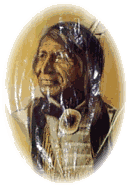
WOFFORD'S STATION

Wofford's Station was built in 1793 in what is now the Northeast corner of Banks County. Wofford's Station was the very first white settlement in the area. All that is left today is a stone reputed to be the foundation for the gatepost. But if you enjoy history and stories it takes very little imagination to look around and see what might have been. Wofford's Station was built to protect white settlers from the Native Americans. There is not any record that any trouble ever occurred between the Indians and whites at or near Wofford's Station.
The Station did have problems with it's own government however. Until the removal of the Cherokees to Oklahoma all of what is known as North Georgia belonged to the Cherokee. In 1782 they were encouraged to sign a treaty settling the northern boundary of Georgia and Generals Elijah Clark and Andrew Pickens convinced them it was "in their best interest". The Treaty of Long Swamp , confirmed by the State of Georgia in 1783 described the Northern boundary as running from just southwest of present day Toccoa to the Hog Mountain area of Gwinnett County.
The President appointed Andrew Elliott to run and mark this line but according to the papers at the State Archive he appointed his brother Joseph Elliott . For reasons unknown, Joseph Elliott never did the survey. During this time Stockades such as Wofford's were built and usually manned by State Militia . Most settlers lived too far apart and too far away for the Militia to help them . Therefore one person was appointed to build a fort that anyone could take refuge in by the Governor. Improvements to the stockade was paid by the State.
The founder of Wofford's Station was Nathaniel Wofford. He was born in Maryland in 1728 and moved to Georgia in 1782. Three weeks after Wofford bought the land in what was then Franklin County the first Adjuntant C.G. Etholm, came and inspected the fort. He described the fort as," four rifles, 3 muskats, and two fusies and situated on the Middle Fork of Broad River near the Curahee Mountain.". After giving instructions for improvements the Adjunct General certified Wofford's Station as being worth 14 pounds or about $36.00
In 1798 Col Benjamin Hawkins finally surveyed the line and the folks in the Wofford Station settlement found themselves outside Georgia in Cherokee land! That line is marked by what is known as The Line Baptist Church . On Sep 13, 1798, the residents of Wofford's Settlement sent a petition to Gov. Jackson asking him to allow them to continue living on their land. The petition was signed by 35 residents. Gen. Wofford , at more than 70 years old , rode on horseback to Washington to deliver the petition to President Jefferson. The settlers held that the fault was not theirs but it was the fault of the State of Georgia for selling the land to them.
Finally in 1804 the Treaty of Tellico was signed by the whites and the Cherokees. This treaty gave the State a strip of land 23 miles long and four miles wide, known as the four-four mile purchase. Woffords settlement was finally a part of Georgia.
Residents of Wofford' Settlement
William Wofford , Benjamin Wofford , Nathaniel Wofford , William Alred , Jesse Austin , Mathew Alexander , Thomas Bernard , John Bland , Amos Bowling , Augustine Brown , Robert Brown , William Bright , Richard Burks , David Clarke , John Collins , Charles Crawford , Jesse Dean , William Hartgrove , Moses Holcom , George Hopper , Thomas Hopper , Richard Lay , Lucas LeCroy , Garlaand Lane , Robert Little , Jacob Loughridge , Robert Mahan , Equila Macracken , James Macracken , Samuel Reid , Samuel Ross , Garnet Smethers , John Strawn , William Taylor , William Weatherspoon , Charles Wells.
copyright by Vicky Chambers 2003
Background by Donna Brand